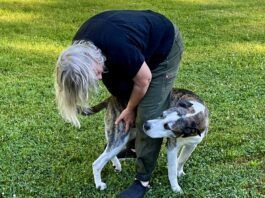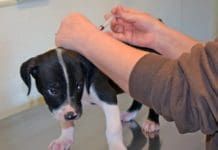Do Dogs Recognize Us With Smell More Than Sight?
We've probably all seen it - dogs who don't seem to recognize obviously familiar people until they get a good sniff of them. Why is that?
More Moving Updates
Two-year-old Woody is the one who is THRILLED with the house. Every morning when I get up and let the dogs outside, he takes off at a swift gallop into the two-acre-field behind the house, running, it seems, for the sheer joy of running. Within the first minute, he will stop and pee, and then run over to a tree in the field that has a hollow trunk. He sniffs around its base, and stands on his hind legs to sniff the inside. There must be SOME animal living in there, or going in there on a regular basis.
Puppy Vaccination Protocols Vary
There is no universal vaccination protocol for dogs because of differing opinion among veterinarians, and also because of the ways in which "DIY" vaccinations are marketed and distributed to pet owners. The truth about vaccinations is there is no puppy vaccination protocol! Whole Dog Journal editor Nancy Kerns covers puppy vaccinations in this week's blog.
When Our Dogs Face Tragic Accidents
The fact remains, that bad things can happen even to good dog owners. And my family members are some of the best dog owners I know: generous, kind, educated, and deeply devoted to their own dogs and to their breed rescue.
Clean Label Project: Lots of Unfulfilled Dog Food Review Promises
Whole Dog Journal has a lot of nits to pick with the Clean Label Project ratings. We don't usually comment on other sites or individuals who rate or review dog food, but we were compelled to do so in this case out of sheer disappointment. When we first heard of the Clean Label Project, we hoped that the organization had somehow managed to fund a significant number of validated, independent lab tests of dog food, searching for contaminants and nutrient levels that were out of spec, and plainly report the results.
The 2018 Approved Dry Dog Foods List Explained: Quality VS. Cost
WDJ's review of dry dog food appears in the February issue, every year. And, every February, we try to share new information with WDJ's readers about how to differentiate between dry dog foods of varying quality, and how to go about selecting the best foods for their dogs. Some of our readers have been with us for a long time; we don't want to repeat the same information year after year, but strive to share information that is new and interesting, even to people who know a LOT about canine nutrition. But neither do we want to "lose" dog owners who are new to the publication by assuming a level of knowledge of the pet food industry that they don't yet have.
In the February 2018 dry food review, now available to paid subscribers online and in print form, the emphasis is on the cost of quality: what you are paying for with the highest-priced foods, especially as compared to the moderately priced and low-priced foods.
In the February 2018 dry food review, now available to paid subscribers online and in print form, the emphasis is on the cost of quality: what you are paying for with the highest-priced foods, especially as compared to the moderately priced and low-priced foods.
White Bits in Dog Poop*
Warning: This post talks about dog poop. If you are sensitive regarding discussions about dog poop...maybe you don't actually have a dog, and shouldn't be reading this blog at all! Just kidding. Not about the poop, just about the dog-owning part.
Have you ever found a dog poop that has been out in the rain for a while, and observed (as you were picking it up) that it looked like it was full of what looked like bits of white sand? Only, the "grains of sand" were slightly bigger than actual grains of sand? It might take a good week or so of rain, or a poop that started out on the soft side, for you to see this. I found a few in this condition the other day, and it surprised me, because I hadn't seen it for a while - but I knew why that was.
Have you ever found a dog poop that has been out in the rain for a while, and observed (as you were picking it up) that it looked like it was full of what looked like bits of white sand? Only, the "grains of sand" were slightly bigger than actual grains of sand? It might take a good week or so of rain, or a poop that started out on the soft side, for you to see this. I found a few in this condition the other day, and it surprised me, because I hadn't seen it for a while - but I knew why that was.
New House – How Are the Dogs Handling the Move?
As I described in the editorial in the January issue of WDJ, my husband and I recently bought a new house, about four miles from where we currently live. Before, we were living in the center of a little 1850s Gold Rush-era town; now we live on its outskirts, in a 1950s ranch house on two acres.
In the category of loving the new house are three of the four voting members of the family (me, my husband, 10-year-old mixed-breed Otto and two-year-old pit/Lab Woody; cats and chickens don't vote).
In the category of loving the new house are three of the four voting members of the family (me, my husband, 10-year-old mixed-breed Otto and two-year-old pit/Lab Woody; cats and chickens don't vote).
The Hazards of Transporting Puppies
I promise to stop talking about my foster puppies soon. Especially since I'm down to just two of them; soon enough, I won't have anything to say. But today's adventure made me yearn for the day they will all be gone.
I agreed to transport two puppies to meet with a woman who was adopting one of the pups. She was going to transport the second puppy to the base of the West Coast coordinator of the breed rescue who has sponsored this litter (and their heartworm-positive mom); the pup will catch a ride with yet another volunteer in a few days to her new home in southern California - about a 10-hour drive from my house to the puppy's new home, all in all.
I agreed to transport two puppies to meet with a woman who was adopting one of the pups. She was going to transport the second puppy to the base of the West Coast coordinator of the breed rescue who has sponsored this litter (and their heartworm-positive mom); the pup will catch a ride with yet another volunteer in a few days to her new home in southern California - about a 10-hour drive from my house to the puppy's new home, all in all.
What’s in a name?
The breed rescue I'm fostering for has a policy that they use for naming the dogs in their care: All the dogs rescued in a given year are assigned a name that starts with a certain letter (or, in the case of the letters with few names, a few letters, like X, Y, or Z). In contrast, puppies in a litter (like the ones I have) are assigned names taken from songs from a favorite album. One of the rescue coordinators is a big Jimmy Buffett fan, so all the pups I'm fostering have been given names from a certain Jimmy Buffett record. These are generally temporary names, used just to market the dogs and pups on the rescue website and Facebook page. Most people end up re-naming the dogs once they are adopted.
When You Break Your Foster Dog’s Heart
Usually, when I foster, I choose a smart and cute wayward adolescent who needs some training and guidance, and I actively participate in the search for an appropriate home for the dog, and then provide guidance and advice to the new owner. Or, I foster a litter of puppies who are going to be adopted lickety-split. Either way, I usually feel great about the whole thing - getting to help a dog become more likely to succeed in his or her happy new home. Today, though, I'm sort of miserable and sad.As you may have read here before, my most recent fostering project is a heartworm-positive mama hound and her seven puppies. The puppies, as ever, are going to fly off the shelves - that is, they are certain to elicit an ample number of applications from the website of the coonhound rescue responsible for taking on the whole mess and finding the family appropriate homes. But the mama - who is going to take the mother hound?
A Quick Check-in From Puppies-R-Us
It's simply astonishing how fast puppies grow. Three weeks ago I wrote a post about the then-four-week-old puppies I'm fostering. Three weeks ago, they were just starting to show little bits of grown-up dog behavior: adorable little growls and barks, playing with each other, and running toward me when I call them for a meal or to go outside (or come inside). Today, the seven Treeing Walker Coonhound puppies are seven weeks old and just the most amazing, perfectly formed little dogs. They (unfortunately) remember things they learned days ago - like how exactly they got through the barriers I erected in the kitchen to keep them out of the recycling bin, where there are crushed aluminum cans and plastic bottles just waiting to be strewn about the kitchen (so, for a while, the recycling bin will have to be relocated to a table top). Fortunately, they also remember good things, like how they can get attention and petting if they sit in front of me, rather than jumping up or biting my bare ankles (ouch!).


















